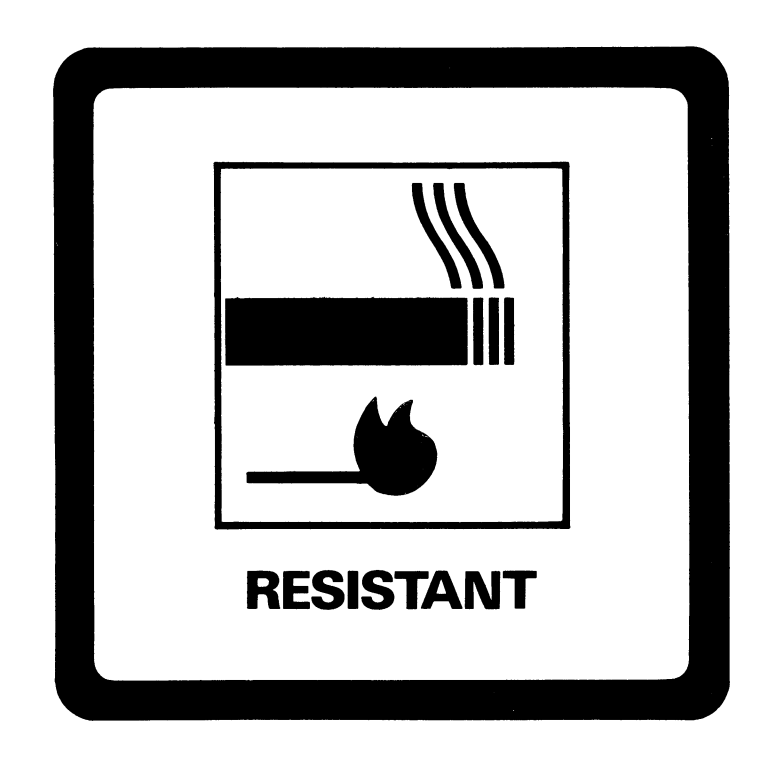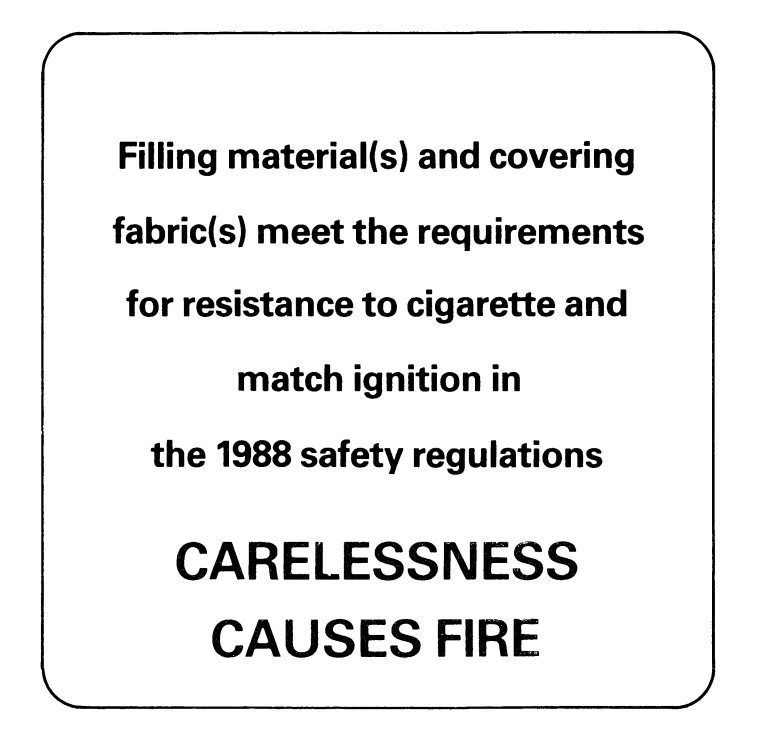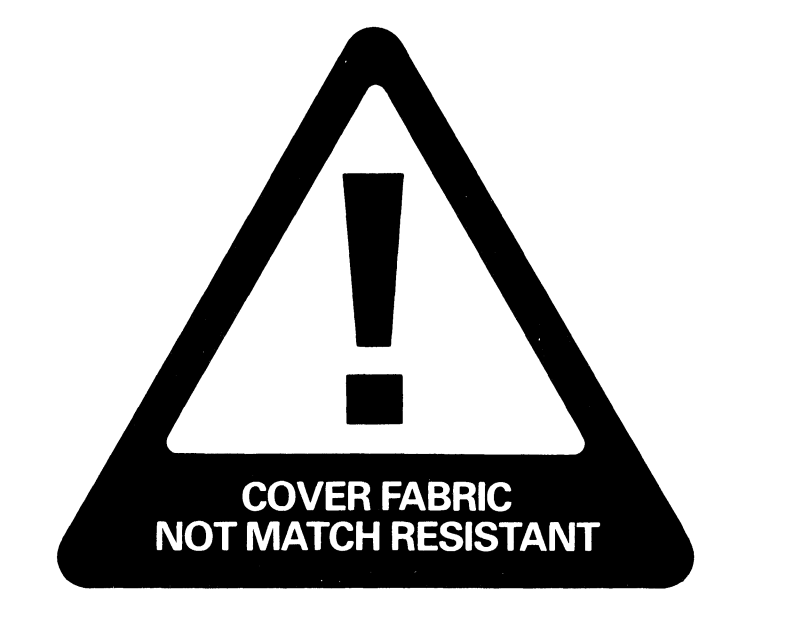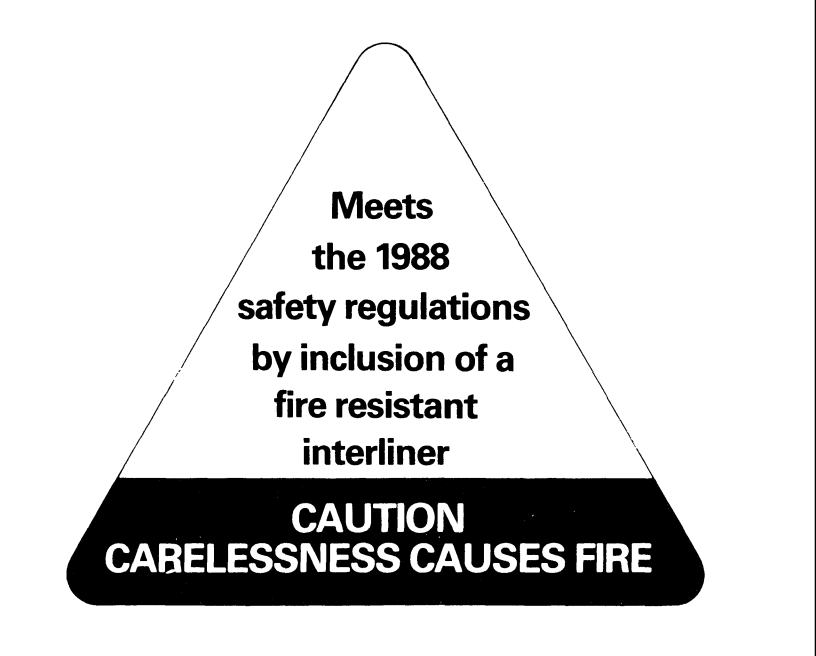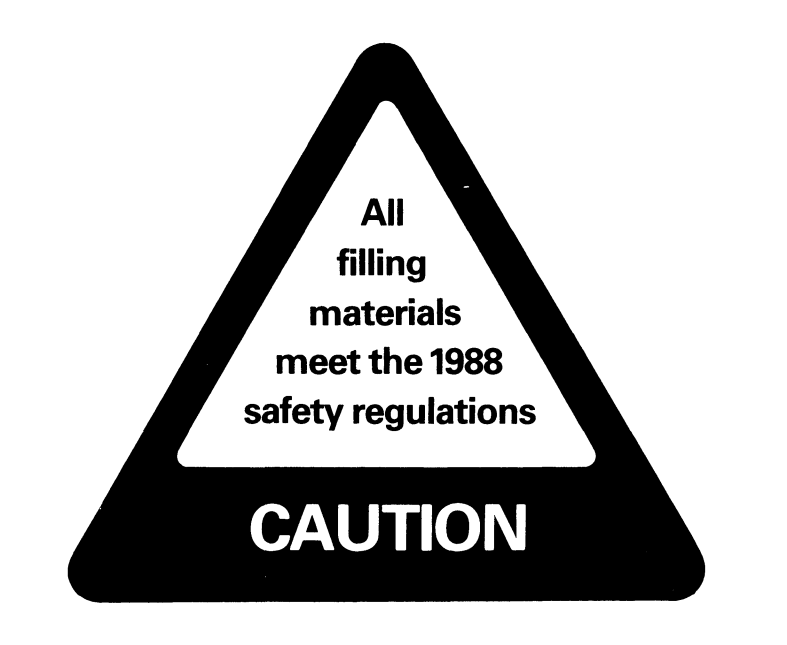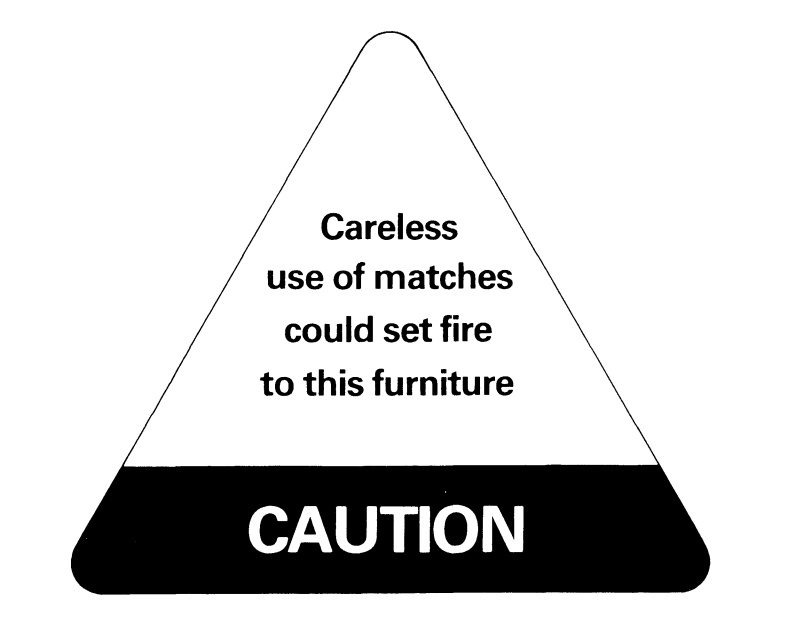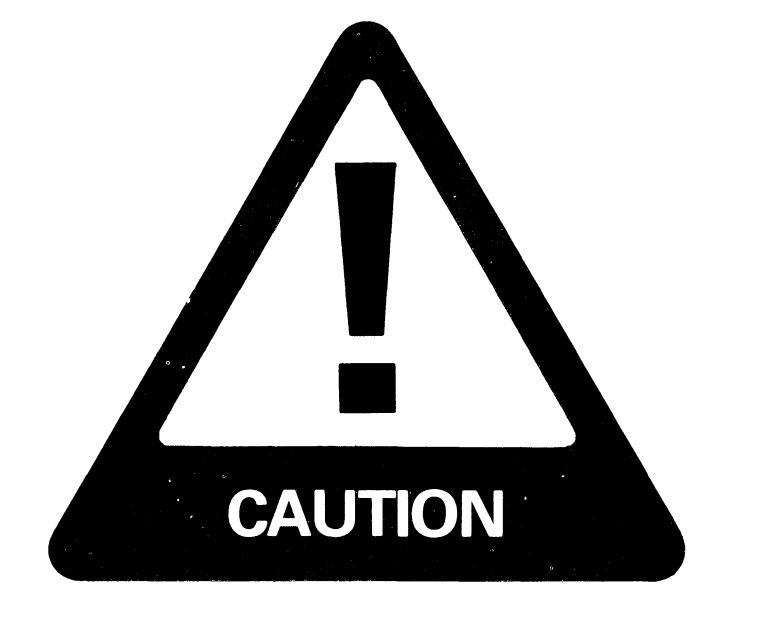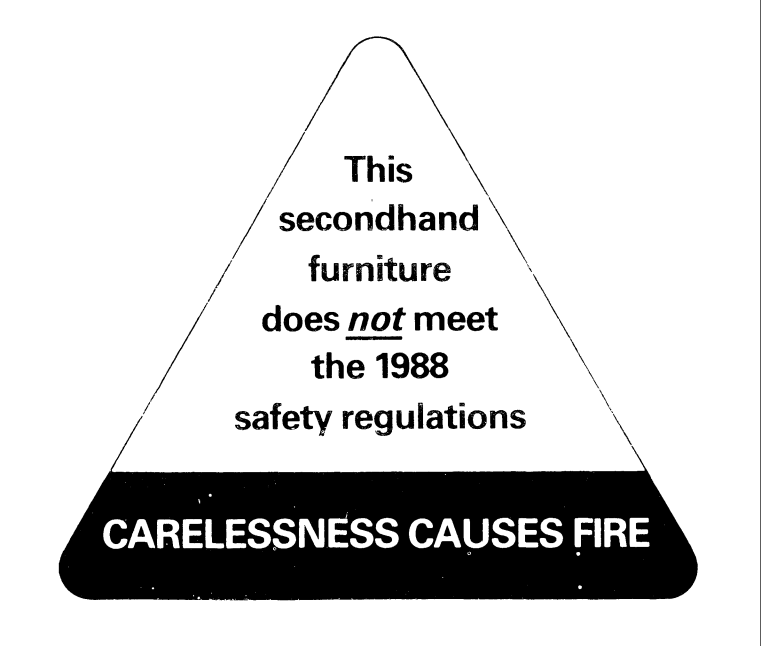Statutory Instruments
1988 No. 1324
CONSUMER PROTECTION
The Furniture and Furnishings (Fire) (Safety) Regulations 1988
Laid before Parliament
28th July 1988
Coming into force in accordance with regulation 1(2)
Whereas the Secretary of State has, in accordance with section 11(5) of the Consumer Protection Act 1987() consulted such organisations as appear to him to be representative of interests substantially affected by these Regulations and such other persons as he considers appropriate:
Now, therefore, the Secretary of State, in exercise of the powers conferred on him by section 11 of the said Act, hereby makes the following Regulations:-�
Citation and Commencement
1.-(1) These Regulations may be cited as the Furniture and Furnishings (Fire) (Safety) Regulations 1988.
(2) These Regulations shall come into force as follows:-�
(a)this regulation and regulations 3 and 4 shall come into force on 1st November 1988;
(b)subject to subparagraph (i) below, regulation 6 (insofar as it relates to foam), 11 (insofar as it relates to foam-filled furniture), 12 (insofar as it relates to foam-filled furniture) and 13 (insofar as it relates to foam-filled furniture) and 15 shall come into force as regards the duties of manufacturers and importers, on 1st November 1988;
(c)regulation 2, insofar as it relates to the revocation of that part of the Upholstered Furniture (Safety) Regulations 1980() as amended by the Upholstered Furniture (Safety) (Amendment) Regulations 1983() which imposes requirements with respect to permanent labels for certain furniture (insofar as those requirements apply to manufacturers and importers), shall come into force on 1st November 1988;
(d)regulation 7 (insofar as it relates to foam filling materials) shall come into force on 1st November 1988 and (insofar as it is not already in force) shall come into force on 1st March 1989;
(e)regulation 2, insofar as it relates to the revocation of that part of the Upholstered Furniture (Safety) Regulations 1980 as amended by the Upholstered Furniture (Safety) (Amendment) Regulations 1983 which imposes requirements with respect to display labels for certain furniture, shall come into force on 1st March 1989;
(f)subject to subparagraph (i) below, regulations 5, 6 (insofar as it relates to non-foam fillings), 11 (insofar as it relates to furniture), 12 (insofar as it relates to furniture) 13 and 15 shall come into force as regards the duties of manufacturers and importers (insofar as they are not already so in force) on 1st March 1989;
(g)subject to subparagraph (i) below, regulations 5, 6, 10, 11 (insofar as it relates to furniture), 12 (insofar as it relates to furniture) and 15 shall come into force as regards the duties of retailers on 1st March 1989;
(h)regulations 8, 9, 10, 11, 12, 13 and 15 (insofar as they are not already in force) shall come into force on 1st March 1990;
(i)insofar as regulations 5, 6, 10, 11, 12 and 13 apply to or in respect of-�
(i)furniture (whether ready-assembled or in component form) which is ordinarily intended for private use in the open air but which is also suitable for use in a dwelling;
(ii)furniture which is ordinarily intended to be affixed to and form part of a caravan;
they shall come into force on 1st March 1990;
(j)regulation 14(2) shall come into force on 1st March 1993; and
(k)otherwise, on 1st March 1990.
Revocation
2. The Upholstered Furniture (Safety) Regulations 1980 and the Upholstered Furniture (Safety) (Amendment) Regulations 1983 are hereby revoked.
Interpretation
3.-(1) In these Regulations-�
"BS 3379" means the British Standard Specification for flexible urethane foam for loadbearing applications BS 3379: 1975 published by the British Standards Institution on 30th May 1975, as amended on 28th April 1978(), subject to any further amendments made thereto and approved by the Secretary of State;
"BS 5651" means the British Standard Specification for cleansing and wetting procedures for use in the assessment of the effect of cleansing and wetting on the flammability of textiles and fabric assemblies BS 5651: 1978 published by the British Standards Institution on 29th December 1978() subject to any amendments made thereto and approved by the Secretary of State;
"BS 5852: Part 1" means the British Standard for fire tests for furniture BS 5852: Part 1: 1979 published by the British Standards Institution and which came into effect on 30th November 1979() subject to any amendments made thereto and approved by the Secretary of State;
"BS 5852: Part 2" means the British Standard for fire tests for furniture BS 5852: Part 2: 1982 published by the British Standards Institution and which came into effect on 31st August 1982() subject to any amendments made thereto and approved by the Secretary of State;
"BS 6807" means the British Standard Methods of test for the ignitability of mattresses with primary and secondary sources of ignition BS 6807: 1986 published by the British Standards Institution and which came into effect on 31st December 1986() subject to any amendments made thereto and approved by the Secretary of State;
"cigarette test" means the smouldering cigarette test specified in BS 5852: Part 1 as modified in accordance with the provisions of Schedule 4 to these Regulations;
"cushions" (except in (a) of the definition of "relevant ignitability test" in this paragraph) means scatter cushions and cushions of the kind commonly used on the seats of wooden chairs;
"dwelling" includes any caravan, but does not include boats or any other vessels or motor vehicles;
"filling material" means any material used for filling or stuffing the upholstered parts of furniture or for filling, bulking-out or stuffing such articles as cushions, mattresses and pillows;
"furniture" means-�
(a)
furniture of any description which is ordinarily intended for private use in a dwelling and includes beds and divans (including the bases and headboards of both), sofa-beds, children's furniture, cots (including carry-cots, playpens, prams and pushchairs and any other article of a like nature and use designed to contain a baby or small child), cushions, high-chairs, mattresses (of any size) and pillows, but does not include bedding or floor coverings (including carpets and mats);
(b)
furniture which is ordinarily intended for private use in the open air but which is also suitable for use in a dwelling; and
(c)
any collection of components designed or intended to be assembled into any article of furniture defined in subparagraphs (a) and (b) above;
and "furniture" includes furniture mentioned in regulation 14(1) (second-hand furniture)-�
in regulations 4, 7 and 15, from 1st November 1988;
in regulations 8(4), 9 and 14, from 1st March 1990;
in regulations 5, 6 and 8(1)-�(3) from 1st March 1993.
"match test" means the test specified in Part I or Part II as appropriate of Schedule 5 to these Regulations;
"relevant ignitability test" in relation to any filling which-�
(a)
consists solely of polyurethane foam in slab or cushion form means the test specified in Part I of Schedule 1 to these Regulations;
(b)
consists solely of polyurethane foam in crumb form means the test specified in Part II of Schedule 1 to these Regulations;
(c)
consists solely of latex rubber foam means the test specified in Part III of Schedule 1 to these Regulations;
(d)
consists of a single filling material other than the materials mentioned in paragraph (a), (b) or (c) above means the test specified in Part I of Schedule 2 to these Regulations;
(e)
consists of more than one filling material means either:-�
(i)
the test specified in Part I of Schedule 2 to these Regulations for each individual filling material tested separately; or
(ii)
the appropriate test specified in Part II, III or IV of that Schedule for the filling material tested as a composite:
provided that if the filling material includes foam of any of the kinds mentioned in paragraph (a), (b) or (c) above, the relevant ignitability test for that part of the filling which consists of such foam shall be the test (or tests) specified in paragraph (a), (b) or (c), as the case may be;
"supply", where the context so admits, includes offering and agreeing to supply and exposing and possessing for supply, and cognate expressions shall be construed accordingly.
(2) For the purposes of these Regulations any references in BS 3379, BS 5651, BS 5852: Part 1, BS 5852: Part 2 or BS 6807 to any other British Standards shall be construed as references to those other British Standards as they had effect on 28th April 1978, 29th December 1978, 30th November 1979, 31st August 1982 and 31st December 1986 respectively or as they had effect on those dates respectively subject to amendments made to them by the British Standards Institution and approved by the Secretary of State.
Exclusion of goods made before 1950 and of supply of materials for re-upholstery of furniture made before that date and of goods for export
4. The requirements of these Regulations do not apply-�
(a)in relation to the supply of any goods manufactured before 1 January 1950;
(b)in relation to the supply of materials when the person supplying them knows or has reasonable cause to believe that they will be used for re-covering or re-upholstering furniture manufactured before 1st January 1950; or
(c)in any case where the person supplying goods to which those requirements relate knows or has reasonable cause to believe that the goods will not be used in the United Kingdom.
Upholstery
5.-(1) No furniture to which this regulation applies shall include upholstery which does not pass the cigarette test.
(2) This regulation applies to all furniture (except mattresses, bed-bases, pillows and cushions).
Filling material
6.-(1) Subject to paragraphs (3) and (4) below, no furniture shall include any filling material which fails the relevant ignitability test.
(2) No furniture shall include as filling any foam in crumb form unless both-�
(a)the foam from which the crumb is derived passes the ignitability test specified in Part I of Schedule 1 to these Regulations; and
(b)the foam in crumb form itself passes the ignitability test specified in Part II of that Schedule.
(3) A cushion may include filling material which does not pass the ignitability test specified in Part I or Part II (or both such parts) of Schedule 2 to these Regulations if the cushion has a primary cover and, with that cover, passes the ignitability test in Part III of that Schedule.
(4) A pillow may include filling material which does not pass the ignitability test specified in Part I or Part II (or both such parts) of Schedule 2 to these Regulations if the pillow, when tested with its primary cover, passes the ignitability test in Part III of that Schedule.
Loose fillings
7. No person shall supply any filling material which fails the relevant ignitability test, or which contains foam in crumb form which may not be included in furniture by virtue of regulation 6(2) above, in any case where he knows or has reasonable cause to believe that the material will be used-�
(a)for filling a cushion or a pillow; or
(b)for the purpose of upholstering or re-upholstering furniture.
Permanent Covers
8.-(1) Subject to paragraphs (2) and (3) below, if furniture (other than mattresses, bed-bases, pillows and cushions) is supplied with a cover on it, the cover shall pass the match test in Part I of Schedule 5 to these Regulations.
(2) Where furniture is supplied with a cover on it and there is between it and the cover an interliner which passes the test in Schedule 3 to these Regulations, the cover need not pass the match test.
(3) Paragraph (2) above only applies where the cover is made of a material containing at least 75 per cent by weight of cotton, flax, viscose, modal, silk or wool, used separately or together and not coated with polyurethane or a polyurethane preparation.
(4) No person shall supply any cover or fabric knowing or having reasonable cause to believe that it will be used to provide or replace the permanent cover on any furniture (other than mattresses, bed-bases, pillows and cushions) unless either-�
(a)the cover or fabric supplied passes the match test mentioned in paragraph (1) above; or
(b)the furniture has an interliner which passes the test mentioned in paragraph (2) above and the cover or fabric is of a kind specified in paragraph (3) above.
Covers other than permanent covers
9.-(1) Loose covers (other than stretch covers) for any furniture specified in paragraph (3) below shall pass the match test in Part I of Schedule 5 to these Regulations.
(2) Stretch covers for any furniture specified in paragraph (3) below shall pass the match test in Part II of that Schedule.
(3) In this regulation "furniture" means any furniture other than mattresses, bed-bases, pillows and cushions.
Labelling requirements
Display labels
10.-(1) There shall be attached to furniture to which Schedule 6 to these Regulations applies and which is exposed for supply by retail the appropriate display label specified in that Schedule.
(2) The label mentioned in paragraph (1) above shall be so attached to the furniture as to be clearly visible to anyone inspecting the furniture and to enable him to read both the front and the back of the label with as little inconvenience as is reasonably practicable.
Permanent labels
11. Furniture and covers to which Schedule 7 to these Regulations applies shall bear the permanent labelling specified in Part II or Part III of Schedule 7 to these Regulations in accordance with the provisions of Part II or Part III of that Schedule, as the case may be, (and if the furniture or cover does not bear the permanent labelling specified in Part II of Schedule 7 the requirements of regulation 12 below shall also be complied with in relation to such furniture or cover).
Requirement to give information
12.-(1) This regulation applies to any person who supplies or has supplied within the period of five years (or, if shorter, so much of that period as falls after 1st November 1988) immediately prior to his being required to give the information in question any furniture or cover to which Schedule 7 to these Regulations applies in relation to which the requirements of Part III of Schedule 7 to these Regulations and not those of Part II of that Schedule are satisfied.
(2) The information which may be required by paragraph (4) below is the following information in respect of the furniture or cover specified in paragraph (1) above:-�
(a)the name and the postal code of the address of the principal place of business of the manufacturer or importer who first supplied the article in the United Kingdom;
(b)the date on which the article was manufactured or imported (in its finished form) into the United Kingdom;
(c)the description of all the filling materials included in the article;
(d)the description of all the covering materials included in the article.
(3) The information specified in paragraph (2) above need not be given in relation to-�
(a)cushions and pillows (except for information required by subparagraphs (a) and (c) of paragraph (2) above);
(b)cots, carry-cots, playpens, prams and pushchairs (except for information required by subparagraphs (a), (c) and (d) of paragraph (2) above);
(c)any other article similar in its nature and use to any article in subparagraph (b) of this paragraph and designed to carry a baby or small child (except for information required by subparagraphs (a), (c) and (d) of paragraph (2) above);
(d)covers (except for information required by subparagraphs (a) and (d) of paragraph (2) above).
(4) Any person to whom this regulation applies shall give to an enforcement authority, or any of its officers, the information specified in paragraph (2) above on his being required to give such information at a reasonable time.
First suppliers: requirement to give information
13.-(1) Any person to whom paragraph (3) below applies shall give to an enforcement authority or any of its officers such information as it or he may reasonably require for the purpose of enabling the authority to enforce any of the requirements of these Regulations relating to any furniture other than mattresses, bed-bases, pillows and cushions.
(2) Without prejudice to the generality of paragraph (1) above, information may be required to be given, in accordance with that paragraph, relating to any of the following matters, that is to say-�
(a)the results of any test prescribed by these Regulations carried out on the furniture in question or any of its components;
(b)the means by which those results are attributed to furniture or components of a particular description or batch;
(c)the correspondence of any records with labels, batch numbers of marks appearing on or relating to any goods.
(3) This paragraph applies to any manufacturer or importer who supplies or has supplied within the period of five years (or, if shorter, so much of that period as falls after 1st November 1988) immediately prior to his being required to give the information in question any furniture specified in paragraph (1) above.
Second-hand furniture
14.-(1) This regulation applies to furniture which has previously been supplied (whether before or after 1st March 1990, provided that it is not excluded by regulation 4 above, and whether in the United Kingdom or elsewhere) to any person who acquired it otherwise than for the purposes of a business of dealing in furniture.
(2) Furniture to which this regulation applies shall satisfy the requirements of regulations 5, 6 and 8(1) to (3) subject to the exceptions to those requirements for certain furniture specified in those regulations.
(3) Subject to paragraph (4) below, no person shall supply any furniture to which this regulation applies in the period before 1st March 1993 unless:-�
(a)it meets the cigarette test in the case of furniture to which regulation 3(1) of the Upholstered Furniture (Safety) Regulations 1980() as amended by the Upholstered Furniture (Safety) (Amendment) Regulations 1983() applied; and
(b)there is attached to the furniture the display label specified in Schedule 8 to these Regulations so as to be clearly visible to anyone inspecting the furniture and to enable him to read both the front and the back of the label with as little difficulty as is reasonably practicable.
(4) The display label specified in Schedule 8 to these Regulations need not be attached to the furniture if the furniture meets all the requirements of these Regulations which would have had to be met if paragraph 2 of this regulation had been in force.
Prohibition on supply
15.-(1) Subject to paragraph (2) below, no person shall supply any furniture or other article in respect of which any of the requirements of these Regulations is not satisfied.
(2) Paragraph (1) above does not apply where the furniture or other article is supplied as part of the fixtures and fittings of a caravan which is being supplied at the same time and which has previously been supplied (whether before or after 1st November 1988 and whether in the United Kingdom or elsewhere) to any person who acquired it otherwise than for the purposes of a business of dealing in caravans.
Eric Forth
Parliamentary Under-Secretary of State,
Department of Trade and Industry
26th July 1988
Regulations 3, 6 and 7
SCHEDULE 1
PART I
Ignitability test for polyurethane foam in slab or cushion form.
1. The foam shall be tested in accordance with the method set out in BS 5852: Part 2 using cover fabric corresponding to the specification set out in paragraph 2 below.
2. The fabric shall be made of 100 per cent flame retardant polyester fibre. Its construction shall be woven to a plain weave. The yarn in the warp shall be of 1.6 decitex fibre, spun to a linear density of 37 tex, Z twist at 420 turns per metre. The fabric shall be woven to 20.5 yarn threads per centimetre in the warp.
The yarn in the weft shall be of 3.3 decitex fibre spun to a linear density of 100 tex, Z twist at 550 turns per metre. The fabric shall be woven to between 12.6 and 13 threads per centimetre in the weft.
The fabric finish shall be scoured and heat set. Its mass shall be 220 g per m2 plus or minus 5 per cent.
3. The test rig as specified in clause 6.1.1 of BS 5852: Part 2 shall have expanded steel platforms of not less than 28×6 mm mesh size. The test rig is placed on a metal tray of sufficient dimensions to collect any debris falling from specimens being tested. The rig and debris tray shall be mounted on a weighing balance with a remote readout having a full-scale deflection of at least 0 to 20 kg to an accuracy of 2 g.
4. The foam under test, cut to the specified dimensions is placed on the test rig, covered with the fabric specified in paragraph 2 above and tensioned with clips as set out in BS 5852: Part 2. An ignition source 5 crib is placed in position. The mass of the complete assembly is determined ("initial mass"). The test shall be carried out in accordance with BS 5852: Part 2. In particular flaming or smouldering failure shall be determined against the criteria of clause 4 of BS 5852: Part 2.
After flaming and smouldering has ceased, any debris which has become detached from the specimen shall be removed. The remaining mass of the assembly ("final mass") is then recorded.
5. If failure against the criteria of clause 4 of BS 5852: Part 2 has occurred but only by way of damage exceeding the limits defined in clauses 4.1(e), 4.1(f) and 4.2(f) and provided that the resultant mass loss (initial mass less final mass) is less than 60 g the foam passes the ignitability test.
PART II
Ignitability test for polyurethane foam in crumb form.
1. The foam shall be tested in accordance with the method set out in BS 5852: Part 2 using cover fabric corresponding to the specification set out in paragraph 2 below.
2. The fabric shall be made of 100 per cent flame retardant polyester fibre. Its construction shall be woven to a plain weave. The yarn in the warp shall be of 1.6 decitex fibre, spun to a linear density of 37 tex, Z twist at 420 turns per metre. The fabric shall be woven to 20.5 yarn threads per centimetre in the warp.
The yarn in the weft shall be of 3.3 decitex fibre spun to a linear density of 100 tex, Z twist at 550 turns per metre. The fabric shall be woven to between 12.6 and 13 threads per centimetre in the weft.
The fabric finish shall be scoured and heat set. Its mass shall be 220 g per m2 plus or minus 5 per cent.
3. The test rig panels are lined with the fabric specified in paragraph 2 above. Sufficient crumb foam shall be placed upon the seat and back panels so that when the cover fabric piece is placed over them, both are stuffed to the density used in the furniture as intended. The test is then carried out in accordance with BS 5852: Part 2 using ignition source 2 as specified therein.
4. If smouldering or flaming failure against the criteria of clause 4 of BS 5852: Part 2 has not occurred or has occurred only by way of damage exceeding the limits defined in Clauses 4.1(e), 4.1(f) and 4.2(f), the crumb foam passes the ignitability test.
PART III
Ignitability test for latex rubber foam.
1. The foam shall be tested in accordance with the method set out in BS 5852: Part 2 using cover fabric corresponding to the specification set out in paragraph 2 below.
2. The fabric shall be made of 100 per cent flame retardant polyester fibre. Its construction shall be woven to a plain weave. The yarn in the warp shall be of 1.6 decitex fibre, spun to a linear density of 37 tex, Z twist at 420 turns per metre. The fabric shall be woven to 20.5 yarn threads per centimetre in the warp.
The yarn in the weft shall be of 3.3 decitex fibre spun to a linear density of 100 tex, Z twist at 550 turns per metre. The fabric shall be woven to between 12.6 and 13 threads per centimetre in the weft.
The fabric finish shall be scoured and heat set. Its mass shall be 220 g per m2 plus or minus 5 per cent.
3. The foam under test cut to the specified dimensions is placed on the test rig, covered with the fabric specified in paragraph 2 above and tensioned with clips as set out in BS 5852: Part 2. The test is then carried out using ignition source 2 as specified therein.
4. If smouldering or flaming failure against the criteria of clause 4 of BS 5852: Part 2 does not occur, the latex rubber foam passes the ignitability test.
Regulations 3, 6 and 7
SCHEDULE 2
PART I
Ignitability test for non-foam filling materials singly.
1. The filling material shall be tested in accordance with the method set out in BS 5852: Part 2 using cover fabric to the specification in paragraph 2 in Part I of Schedule 1 to these Regulations.
2. The specimen comprising the filling material to be tesed and the specified cover fabric shall be tested with ignition source 2 as specified in BS 5852: Part 2. Where the filling material is loose it shall be packed as indicated in paragraph 3 in Part II of Schedule 1.
3. If smouldering or flaming failure against the criteria of clause 4 of BS 5852: Part 2 has not occurred or has occurred only by way of damage exceeding the limits defined in clause 4.1(e), 4.1(f) and 4(2)(f) the non-foam filling passes the ignitability test.
PART II
Ignitability test for composite fillings for furniture other than mattresses, bed-bases, cushions and pillows.
The composite fillings, covered with the primary cover are built up on the test rig as described in BS 5852: Part 2. The covering fabric shall be that specified in paragraph 2 in Part I of Schedule 1. The test procedure with the use of ignition source 2 specified in BS 5852: Part 2 and the criteria of failure shall be as specified therein.
PART III
Composite test for ignitability of pillows and cushions with primary covers.
1. For pillows the test specimen shall comprise the filling and the primary cover of the pillow. Where the filling is of a loose nature the specimen shall be prepared as set out for loose fillings in paragraph 3 in Part II of Schedule 1. The test procedure using ignition source 2 shall be as specified in BS 5852: Part 2. If smouldering or flaming failure against the criteria of clause 4 of BS 5852: Part 2 has not occurred or has occurred only by way of damage exceeding the limits defined in clause 4(1)(e), 4(1)(f) and 4(2)(f), the composite pillow filling passes the ignitability test.
2. For cushions with primary covers the test specimen shall be made up of filling, the primary cover and standard fabric as in Schedule 1 Part I, paragraph 2. Where the filling is loose, it shall be packed as set out in Schedule 1 Part II, paragraph 3. The test procedure using ignition source 2 shall be as specified in BS 5852: Part 2. If smouldering or flaming failure against the criteria of clause 4 of BS 5852: Part 2 has not occurred or has occurred only by way of damage exceeding the limits defined in clause 4(1)(e), 4(1)(f) and 4(2)(f) the composite cushion filling passes the ignitability test.
PART IV
Ignitability test for composite fillings of mattresses and bed-bases.
1. The test specimen shall be prepared as set out in BS 6807. It may be constructed from the filling materials to be used or by removing existing ticking from a mattress or upholstered divan or bed-base.
2. The specified test fabric as in Schedule 1 Part I paragraph 2, shall be used as the cover fabric. It shall be fitted so as to reproduce the tension in the original article where this is being tested.
3. The test shall be carried out according to Section Four of BS 6807 using ignition source 2 as specified in BS 5852: Part 2. Smouldering or flaming failure shall be as defined in BS 5852: Part 2.
Regulation 8(2)
SCHEDULE 3
Ignition resistance test for interliner.
1. An interliner which is a fabric that has been treated with a fire-retardant chemical to reduce the ignitability of the upholstery shall, before it is conditioned in accordance with clause 7.1 of B.S. 5852: Part 1, be subjected to the water-soaking procedure set out in clauses 4.2 to 4.5 of B.S. 5651, save that for the second subclause of clause 4.5 there shall be substituted the following:
"After 30 minutes, remove the specimen, rinse in water (4.2.1) using a liquor ratio of 1:20 for 2 minutes, and then dry the specimen by any method suitable for the fabric type."
2. The interliner, water-soaked or not as the case may be, shall be tested using cover fabric corresponding to the specification set out in paragraph 3 below and foam filling corresponding to the specification set out in paragraph 4 below. The test shall be conducted using ignition source 5 of BS 5852: Part 2.
3. The fabric shall be made of 100 per cent flame retardant polyester fibre. Its construction shall be woven to a plain weave. The yarn in the warp shall be of 1.6 decitex fibre, spun to a linear density of 37 tex, Z twist at 420 turns per metre. The fabric shall be woven to 20.5 yarn threads per centimetre in the warp.
The yarn in the weft shall be of 3.3 decitex fibre spun to a linear density of 100 tex, Z twist at 550 turns per metre. The fabric shall be woven to between 12.6 and 13 threads per centimetre in the weft.
The fabric finish should be scoured and heat set. Its mass shall be 220 g per m2 plus or minus 5 per cent.
4. The filling material for the test shall be non fire-retardant polyurethane foam corresponding to the specification set out in BS 3379 Type B Hardness grade 130 and of a density of 20-�22 kg per m3.
5. The criteria of failure shall be those specified in clause 4 of BS 5852: Part 2.
Regulations 3 and 5
SCHEDULE 4THE CIGARETTE TEST
Modifications to BS 5852: Part 1
1. Appendix A of B.S. 5852: Part 1 shall be disregarded.
2. All braids and other trimmings shall be removed from material upon which a test is to be conducted.
3. Any covering fabric or fire-barrier material which has been treated with a fire-retardant chemical to reduce the ignitability of the upholstery shall, before it is conditioned in accordance with clause 7.1 of B.S. 5852: Part 1, be subjected to the water-soaking procedure set out in clauses 4.2 to 4.5 of B.S. 5651, save that for the second subclause of clause 4.5 there shall be substituted the following:
"After 30 minutes, remove the specimen, rinse in water (4.2.1) using a liquor ratio of 1:20 for 2 minutes, and then dry the specimen by any method suitable for the fabric type."
4. Where a test is to be conducted in respect of furniture which has no upholstered back and no upholstered arms, the materials on the test rig shall be arranged as if the furniture had an upholstered back the upholstery of which consisted of the same materials as the upholstery of the seat; and where a test is to be conducted in respect of furniture which has an upholstered back or upholstered arms but no upholstered seat, the materials on the test rig shall be arranged as if the furniture had an upholstered seat the upholstery of which consisted of the same materials as the upholstery of the back or arms.
5. Where the upholstery to be tested is such that the materials in one part of the furniture are not the same as those in another part, separate tests shall be conducted in respect of each part as if each part were the seat of furniture which had no upholstered back and no upholstered arms, save that no test shall be conducted in respect of a part the upholstery of which consists of the same materials as the upholstery of a part in respect of which a test has already been conducted; and in this paragraph, "part" means the back, the seat or the arms.
6. Where seams are exposed as part of the design of the covering material, at least one seam in respect of each test to be conducted shall be so aligned on the test rig that it crosses the junction of the back and the seat at approximately right angles thereto and not less than 50 mm from the nearest side edge, and the test (or, in the case of a test which is repeated, the first test) shall be conducted with the cigarette placed across the seam at that junction.
Regulations 3, 8 and 9
SCHEDULE 5THE MATCH TEST
PART I
1. All braids and other trimmings shall be removed from material upon which a test is to be conducted.
2. Any covering fabric which has been treated with a fire-retardant chemical to reduce the ignitability of the upholstery shall, before it is conditioned in accordance with clause 7.1 of B.S. 5852: Part 1 be subjected to the water-soaking procedure set out in clauses 4.2 to 4.5 of B.S. 5651, save that for the second subclause of clause 4.5 there shall be substituted the following:
"After 30 minutes, remove the specimen, rinse in water (4.2.1) using a liquor ratio of 1:20 for 2 minutes, and then dry the specimen by any method suitable for the fabric type."
3. The test shall be carried out in accordance with those provisions of BS 5852: Part 1 which relate to butane flame ignition source 1. The filling material for this test shall be non-fire retardant polyurethane foam corresponding to the specification set out in BS 3379 Type B Hardness grade 130 and of a density of 20-�22 kg per m3.
4. The criteria of failure shall be those specified in clause 4 of BS 5852: Part 1.
PART IITHE MATCH TEST FOR STRETCH COVERS
The test for stretch covers shall be conducted in the same way as for other cover materials except that the filling material over which the fabric is tested shall be a foam which passes the ignitability test in Part I of Schedule 1 and which has a density of 24-�26 kg per m3.
Regulation 10
SCHEDULE 6
PART I
1. This Schedule applies to all furniture except mattresses, bed-bases, pillows and cushions.
2. The appropriate display labels are set out in Parts II, III and IV of this Schedule.
3. The display label shall be substantially in the form (including size, colours used and size and type of print used) of the label in Part II, III or IV of this Schedule, as the case may be.
4. In the case of furniture sold as a collection of pieces (such as three-piece suites) the appropriate display label shall be attached to each individual piece.
PART II
Where the requirements of regulations 5, 6, and 8(1) of these Regulations are complied with the appropriate display label is:-�
PART III
Where the furniture has a permanent cover which does not pass the test in regulation 8(1) but has an interliner which passes the test in Schedule 3 to these regulations and the furniture satisfies the requirements of regulations 5 and 6 the appropriate display label is:-�
PART IV
During the period between 1st March 1989 and 28th February 1990 where only the requirements of regulations 5 and 6 are complied with the appropriate display label is:-�
Regulation 11
SCHEDULE 7PERMANENT LABELLING REQUIREMENTS
PART I
1. This Schedule applies to all furniture (except mattresses and bed-bases) which includes upholstery and to the covers referred to in regulation 9(1) and (2) above.
PART II
1. Subject to paragraphs 2 and 3 below, articles mentioned in Part I of this Schedule shall bear a label which sets out, in order, the following-�
(a)the words "CARELESSNESS CAUSES FIRE";
(b)the name and the postal code of the address of the principal place of business of the manufacturer or importer who first supplied the article in the United Kingdom;
(c)the batch number or identification number (if any) of the article in question;
(d)the date on which the article was manufactured or imported (in its finished form) into the United Kingdom;
(e)the description of all the filling materials included in the article;
(f)the description of all the covering materials included in the article; and
(g)whether or not the article includes an interliner which passes the test in Schedule 3 to these Regulations.
2.-(a) the matters set out in subparagraphs (c), (d), (f) and (g) of paragraph 1 above need not appear on labels required for cushions and pillows;
(b)the matters set out in sub-paragraphs (c), (d) and (g) of paragraph 1 above need not appear on labels required for:
(i)cots, carry-cots, playpens, prams and pushchairs;
(ii)any other article similar in its nature and use to any article in b(i) above and designed to contain a baby or small child.
3. The matters set out in subparagraphs (c), (d), (e) and (g) of paragraph 1 above need not appear on labels required for covers.
4. The labels specified in this Part of this Schedule may, in the case of covers, appear anywhere on the cover and, in the case of other articles, shall appear on an external surface of the article but in every case the labels shall not appear so as to obscure any label or mark required to appear on the article by or under any enactment.
5. In the case of furniture sold as a collection of pieces (such as three-piece suites) and in the case of covers which are so sold the label shall be attached to each individual piece.
6. The wording and numbering specified in this Part of this Schedule shall appear in medium letters of at least 10 point in upper or lower case and shall be set out in legible and durable form on a background of a sufficiently contrasting colour to enable the wording and numbering to be clearly seen.
The label on which the wording and numbering appears shall itself be durable and shall be securely attached to the article in question.
PART III
1. Subject to paragraphs 2 and 3 below, articles mentioned in Part I of this Schedule shall bear a label which sets out, in order, the following-�
(a)the words "CARELESSNESS CAUSES FIRE";
(b)the batch number or identification number (if any) of the article in question;
(c)whether or not the article includes an interliner which passes the test in Schedule 3 to these Regulations; and
(d)a summary of the measures which have been taken to ensure that the article complies with the requirements of these Regulations.
2. The matters set out in subparagraphs (b) and (c) of paragraph 1 above need not appear on labels required for-�
(a)cushions and pillows;
(b)cots, carry-cots, playpens, prams and pushchairs;
(c)any other article similar in its nature and use to any article in subparagraph (b) above and designed to contain a baby or small child;
(d)covers.
3. The labels specified in this Part of this Schedule may, in the case of covers, appear anywhere on the cover and, in the case of other articles, shall appear on an external surface of the article but in every case the labels shall not appear so as to obscure any label or mark required to appear on the article by or under any enactment.
4. In the case of furniture sold as a collection of pieces (such as three-piece suites) and in the case of covers which are so sold the label shall be attached to each individual piece.
5. The wording and numbering specified in this Part of this Schedule shall appear in medium letters of at least 10 point in upper or lower case and shall be set out in legible and durable form on a background of a sufficiently contrasting colour to enable the wording and numbering to be clearly seen.
The label on which the wording and numbering appears shall itself be durable and shall be securely attached to the article in question.
Regulation 14(3)
SCHEDULE 8
Display label for second-hand furniture in period before regulation 14(2) comes into force (that is, before 1st March 1993).
The display label required by regulation 14(3) (subject to regulation 14(4) ) to be attached to furniture which regulation 14(1) applies in the period before 1st March 1993 is:-�
Explanatory Note
These Regulations ("the Regulations") which revoke the Upholstered Furniture (Safety) Regulations 1980 as amended by the Upholstered Furniture (Safety) (Amendment) Regulations 1983 impose requirements in relation to new domestic furniture, including garden furniture which may be used indoors and furniture for use in caravans, subject to exceptions from some of the Regulations for certain furniture. Some of the requirements apply to second-hand furniture. The Regulations do not apply to goods for export or to the supply of goods made before 1st January 1950 or to the supply of materials intended for re-upholstering furniture made before that date.
The main provisions of the Regulations are as follows:-�
(a)no furniture (other than mattresses, bed-bases, pillows and cushions) may include upholstery which does not pass the cigarette test as defined in regulation 3(1) (regulation 5);
(b)no furniture (other than pillows and cushions) may include any filling material which fails the relevant ignitability test as defined in regulation 3(1) and no furniture may include as filling any crumb foam which is not derived from combustion-modified foam (regulation 6);
(c)loose filling material may not be supplied for filling pillows or cushions or upholstering or re-upholstering furniture if it fails the relevant ignitability test or if it contains crumb foam which is not derived from combustion-modified foam (regulation 7);
(d)if furniture (other than mattresses, bed-bases, pillows and cushions) is supplied with a permanent cover the cover must pass the match test as defined in regulation 3(1) unless the cover is made of a specified material and the furniture has an interliner which passes the test in Schedule 3 (regulation 8(1) to (3));
(e)a cover or fabric intended to replace the permanent cover on furniture mentioned in regulation 8(1) may not be supplied unless the cover or fabric passes the match test or the furniture has an interliner which passes the test in schedule 3 and the cover or fabric is of a specified material (regulation 8(4));
(f)covers other than permanent covers for furniture except mattresses, bed-bases, pillows and cushions must pass the appropriate match test (regulation 9);
(g)the appropriate display label as set out in Schedule 6 is to be attached to furniture other than mattresses, bed-bases, pillows and cushions which is exposed for supply by retail (regulation 10);
(h)permanent labels are to be attached to furniture (except mattresses and bed-bases) which include upholstery and to covers other than permanent covers (regulation 11) and if the label is not in the longer form (as specified in Part II of Schedule 7) the additional information set out in regulation 12 must be supplied to an enforcement authority, if required;
(i)manufacturers and importers must supply the information specified in regulation 13 to an enforcement authority, if required to do so;
(j)second-hand furniture is required to comply with regulations 5, 6 and 8(1) to (3) from 1st March 1993 (regulation 14(2); regulation 1(2)(j)) and in the period from 1st March 1990 until 1st March 1993 second-hand furniture may only be supplied subject to the requirements of regulation 14(3) taken with regulation 14(4);
(k)the supply (including the offering and agreeing to supply and the exposing and possessing for supply) of any furniture or other article in respect of which any of the requirements of the Regulations is not satisfied is prohibited, subject to an exception for goods which are supplied as part of a caravan which is being supplied second-hand (regulation 15).
The provisions of the Regulations come into force on various dates between 1st November 1988 (when regulation 6 insofar as it relates to foam comes into force as regards the duties of manufacturers and importers, subject to a postponement for garden furniture and furniture for caravans) and 1st March 1993 (regulation 1(2)).
The Regulations refer to the provisions of the British Standards set out in regulation 3. The Regulations do not require testing to be carried out by a United Kingdom test house. If equivalent Standards giving the appropriate level of protection are adopted in other member States or by other bodies the Regulations may be amended so as to refer also to such Standards.
Copies of the British Standards referred to in the Regulations may be obtained from any of the sales outlets operated by the British Standards Institution (BSI) or by post from the BSI at Linford Wood, Milton Keynes, MK14 6LE.


